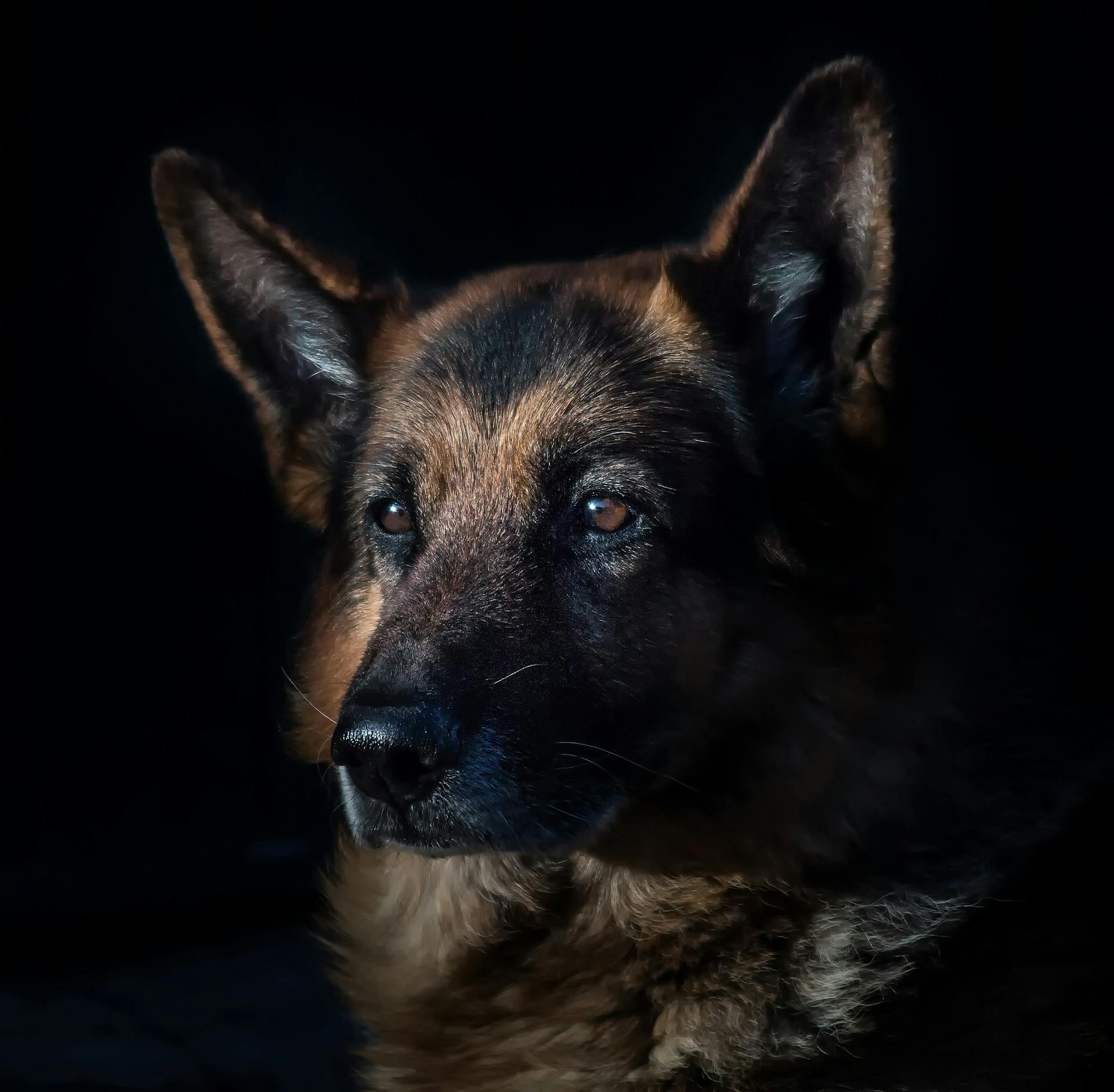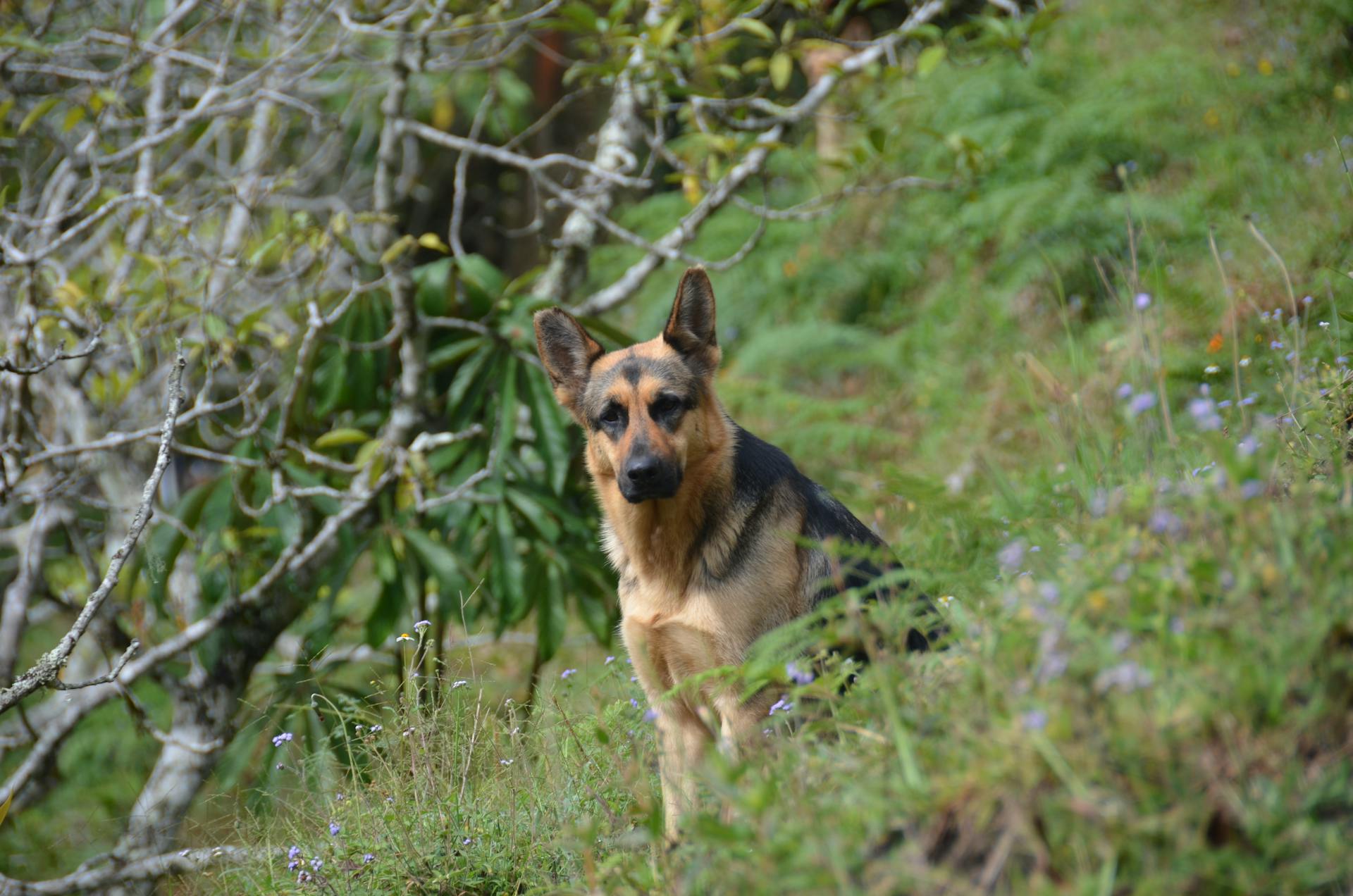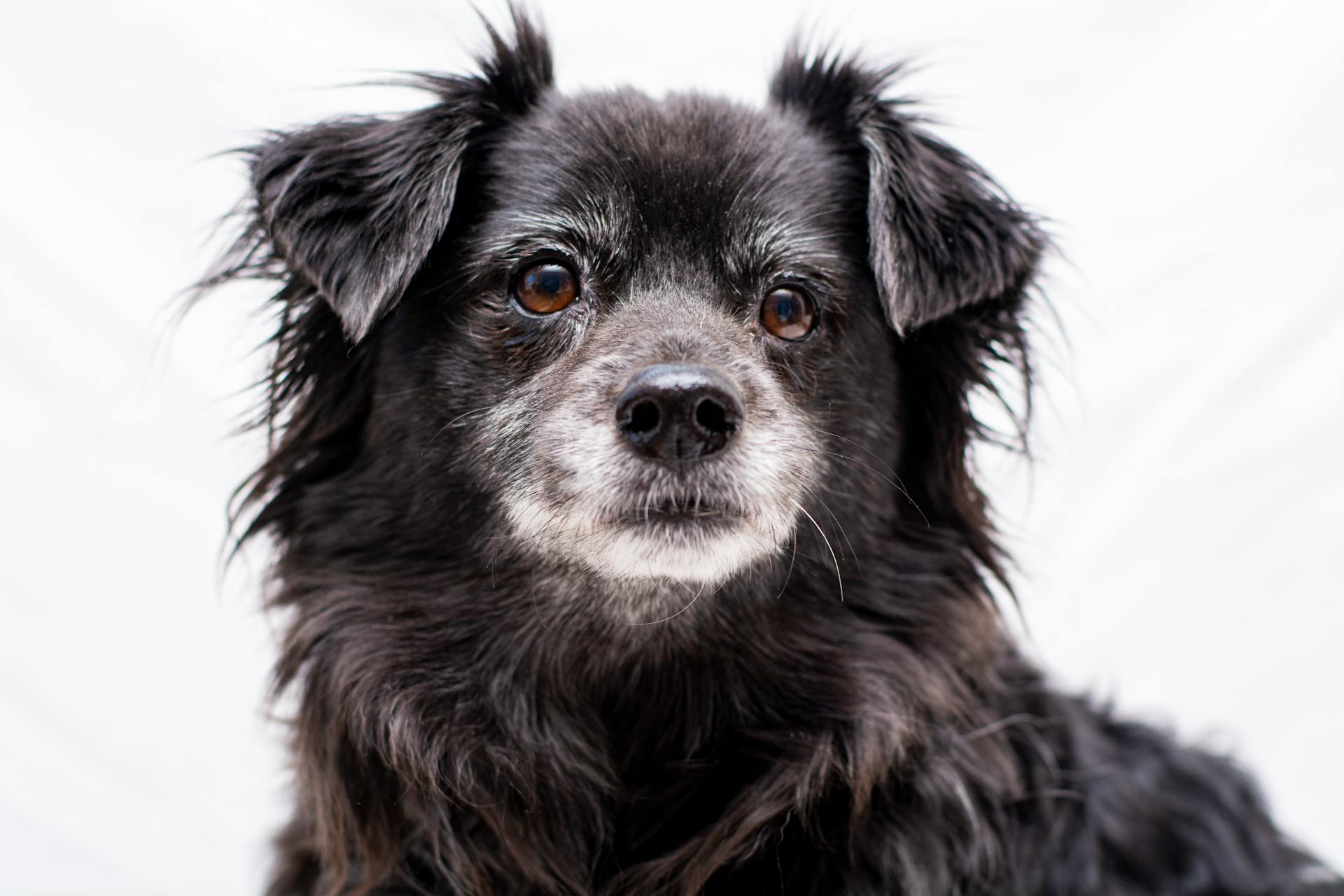
German Shepherds are known for their thick, double coats, which can make them look like they're wearing a furry cloak. This double coat is made up of a soft undercoat and a coarser outer coat.
During certain times of the year, German Shepherds will blow their coat, shedding the old coat to make way for a new one. This process is a natural part of their life cycle.
German Shepherds typically blow their coat twice a year, in the spring and fall, as the weather starts to change. This is when their body naturally sheds the old coat to adapt to the new temperatures.
As a German Shepherd owner, you can expect to see a significant amount of shedding during this time, with some owners reporting up to 50% of their dog's coat falling out in a short period.
You might enjoy: Why Don't Dogs like When You Blow on Them?
Why German Shepherds Shed
German Shepherds shed a lot because of their double coat, which is made up of a dense, straight or slightly wavy topcoat and a soft, wooly undercoat. This double coat protects them from the elements, keeps their skin dry, and acts as a shield from scrapes and cuts.
The reason German Shepherds shed is to protect themselves from the coming seasons. In fall, they shed their undercoat to make way for a new, thicker coat that will keep them warm in the cold winter months. In the spring, they shed that undercoat again, as the thick winter coat is no longer needed.
German Shepherds shed year-round, with a steady flow of dead and loose hair falling from their coat. They also have shedding season, twice a year, during which time the dog will blow its coat. Blowing the coat means shedding the undercoat.
Regular grooming is a great way to minimize shedding and reduce the level of dog fur in the home. German Shepherds need to be brushed 3 or 4 times a week with a grooming tool such as a de-shedder brush, and daily during shedding season.
The type of coat a German Shepherd has also plays a role in how much they shed. Double-coated dogs like German Shepherds tend to shed more than single-coated dogs, and the undercoat is the type of hair that actually sheds.
You might like: Dog Fur Types
How to Manage Shedding
Managing shedding in German Shepherds requires a consistent effort. Brushing your dog every day, ideally for just 5 minutes, can significantly reduce shedding.
Dirty hair is much harder to brush than clean hair, so regular bathing is crucial, especially in dry and dusty climates. A professional-grade grooming blow dryer can make a huge difference in removing the undercoat and reducing shedding.
Daily brushing is the key to removing dead undercoat before it falls out, cutting down on stray hairs in your home. Brushing your dog daily, especially during shedding season, is essential.
Spaying your female dog can also help reduce shedding, as it can prevent heavy shedding after their heat cycle. Male dogs may also experience a lighter coat after neutering.
Regular grooming is a great way to minimize shedding and reduce dog fur in the home. German Shepherds need to be brushed 3 or 4 times a week with a de-shedder brush, and daily during shedding season.
See what others are reading: Different Breeds of Shepherd Dogs
Here are some tips to manage shedding in German Shepherds:
- Brush your dog daily, ideally for 5 minutes
- Bathe your dog regularly, especially in dry and dusty climates
- Use a professional-grade grooming blow dryer to remove the undercoat
- Consider spaying your female dog to reduce shedding
- Brush your dog 3 or 4 times a week with a de-shedder brush, and daily during shedding season
Factors Affecting Shedding
German Shepherds shed seasonally, with a greater amount of hair loss in the spring and fall seasons. This is a natural process as their coat prepares for the changes in weather.
The thickness of their coat is also affected by how much time they spend outside, especially in colder climates. The more time they spend outside, the thicker their coat will grow, resulting in worse shedding during seasonal changes.
A dog's health can also impact shedding. Parasites like fleas, ticks, and mites, nutritional deficiencies, and allergies to pollen, dust, dirt, mold, or ingredients in their food can all cause excessive hair loss.
Here are some common factors that can affect shedding in German Shepherds:
- Parasites (fleas, ticks, and mites)
- Nutritional deficiencies
- Allergies (pollen, dust, dirt, mold, or food ingredients)
Causes of Excessive Hair Loss
German Shepherds are known to be heavy shedders, and it's not just because of their loving nickname "German Shedders." They have a double coat of fur, which includes a dense topcoat and a soft undercoat, that protects against the elements and helps regulate their body temperature.
Having a double coat is a natural adaptation that helps German Shepherds stay healthy and comfortable. It acts as a shield from scrapes and cuts, and helps keep their skin dry.
However, there are times when German Shepherds may shed excessively, and it's not just due to seasonal changes. In fact, German Shepherds shed all year round, but especially during specific shedding seasons.
Here are some common causes of excessive hair loss in German Shepherds:
- Parasites like fleas, ticks, and mites could result in hair loss.
- A nutritional deficiency could lead to a dull coat and increased dead hair.
- Allergies to pollen, dust, dirt, mold, or ingredients in your dog's food can even cause excessive hair loss.
If you suspect one of these health issues in your German Shepherd, it's essential to consult with a veterinarian to get a proper diagnosis and treatment plan. They can help you identify the underlying cause and provide recommendations for keeping your pet healthy and happy.
Exercise
Exercise is essential for reducing shedding in German Shepherds. They need at least 2 hours of exercise each day.
Regular exercise helps manage stress levels, which is a major contributor to excessive shedding. This is because dogs release natural steroids when they're stressed, and exercise helps burn them off.
Exercise also plays a crucial role in weight management. Overweight and obese German Shepherds shed a great deal more than healthy dogs.
The more a German Shepherd is outside running around, the less dog hair you'll find around the home. Many dog owners can attest to this fact.
Shepherd Grooming Tips
German Shepherds are notorious for their heavy shedding, but with the right grooming techniques, you can reduce the amount of stray hairs in your home. Daily brushing can make a huge difference, cutting down on shedding by simply removing the dead undercoat before it falls out.
To brush your German Shepherd effectively, use a de-shedder brush, which gets right into the dog's coat and removes loose and dead hair. Brushing should be done 3 or 4 times a week, with daily brushing during shedding season. Don't be too rough, as pulling on the hair can result in skin irritation.
Brushing also helps prevent matting, which can be painful for your dog. Using a pin brush is recommended, as it can reach all the way through your pup's coat. Regular brushing will also help spread natural oils through the coat, keeping it healthy and shiny.
If you're planning to have a professional groomer take care of your German Shepherd's grooming needs, introduce them to the process as early as possible, ideally as a young puppy. Establish a consistent schedule, such as every 4 weeks, to keep stray hair at bay.
Here are some essential grooming tips to keep in mind:
- Daily brushing can reduce shedding by removing the dead undercoat.
- Use a de-shedder brush to get into your dog's coat and remove loose hair.
- Brush 3-4 times a week, with daily brushing during shedding season.
- Use a pin brush to reach all the way through your pup's coat.
- Establish a consistent grooming schedule with a professional groomer.
Understanding Shedding Patterns
German Shepherds shed year-round, but they have two distinct shedding patterns: a steady flow of dead and loose hair, and a heavier shedding season that occurs twice a year.
This heavier shedding season, also known as blowing the coat, happens in the spring and fall when the dog sheds its undercoat to make way for a new, thicker coat that protects it from the elements. German Shepherds may not need insulation during summer, but they do still require protection from the sun's harmful rays.
During these shedding seasons, owners can expect heavy shedding, with some owners even finding handfuls of hair lying around their homes. It's practically impossible to live with a German Shepherd and not find hair lying around occasionally.
German Shepherds shed their undercoat to protect themselves from the coming seasons. In the fall, they shed their undercoat to make way for a new, thicker coat that will protect them from the cold, increased precipitation, and heavier winds. In the spring, they shed their undercoat again to grow a lighter, less dense coat that will keep them cool.
For another approach, see: Are German Shepherds Good for First Time Owners
Here are the key times when German Shepherds tend to shed heavily:
- Spring: German Shepherds shed their undercoat in the spring to grow a lighter, less dense coat that will keep them cool.
- Fall: German Shepherds shed their undercoat in the fall to make way for a new, thicker coat that will protect them from the cold, increased precipitation, and heavier winds.
This shedding pattern is an instinctual behavior that's very much built into the dog's DNA, and it's essential for their overall health and well-being.
Frequently Asked Questions
How long does it take for a GSD to blow their coat?
German Shepherds typically take 10 days or more to shed their undercoat during their bi-annual coat blow. This process can be a significant commitment for dog owners.
What months do dogs blow their coats?
Dogs typically shed their coats in the spring (lightening their coat for warm weather) and fall (preparing for winter). This seasonal shedding usually occurs between March to May and September to November.
Featured Images: pexels.com


